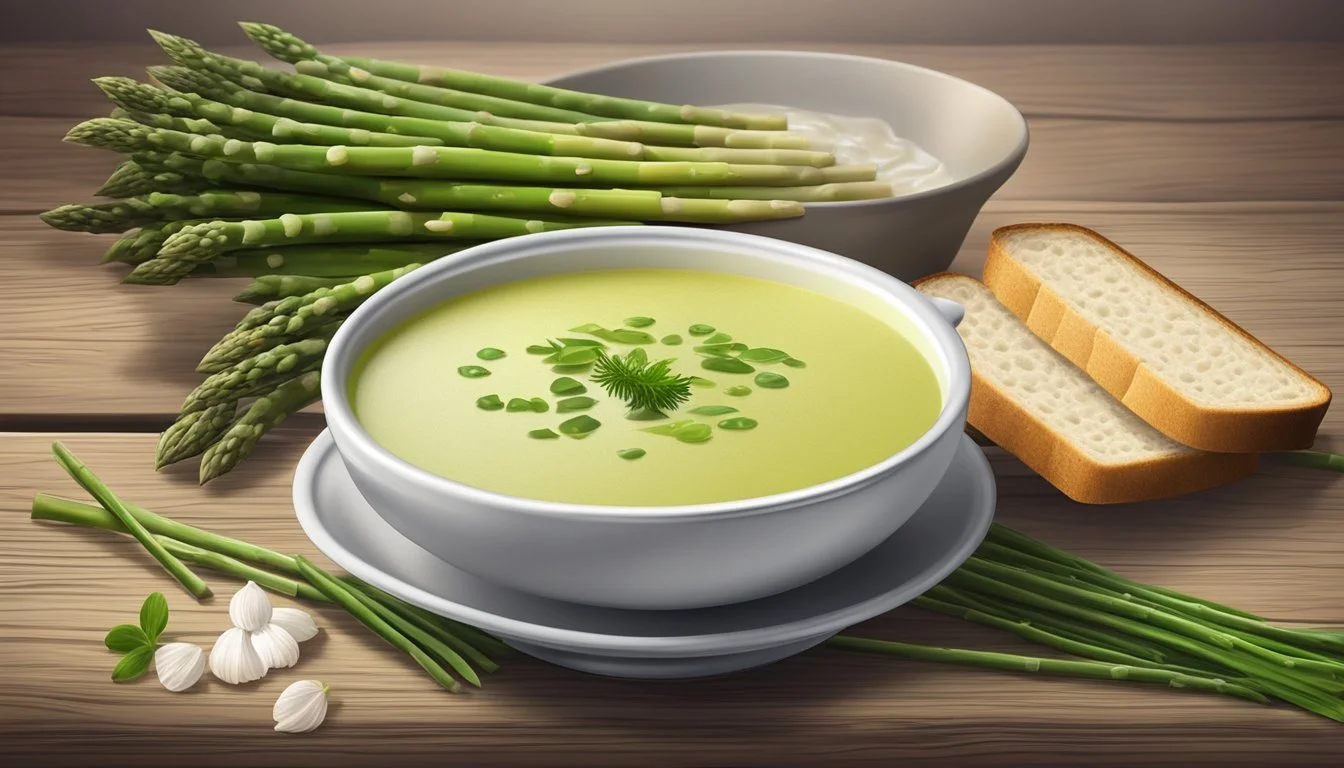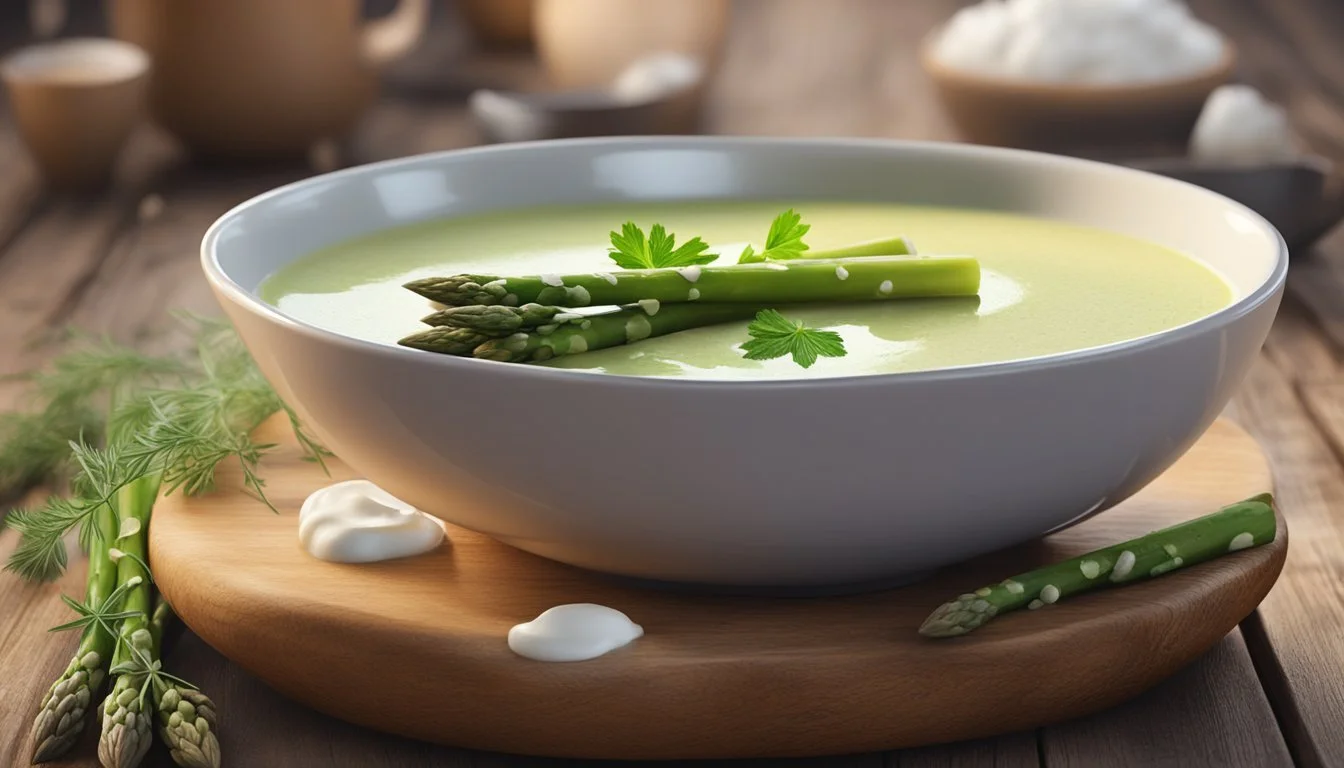Asparagus End Soup
A Creamy, Seasonal Starter to Delight Your Palate
Asparagus (What wine goes well with asparagus?) has long heralded the arrival of spring, bringing with it a delicate flavor and an array of nutritional benefits. As springtime blossoms, chefs and home cooks alike turn to this versatile vegetable to create a dish that truly captures the essence of the season: cream of asparagus soup. This creamy concoction highlights the naturally vibrant taste of asparagus, transforming it into a sumptuous starter that sets the stage for a springtime feast.
The preparation of cream of asparagus soup is straightforward, which makes it suitable for both seasoned chefs and novices in the kitchen. Typically, it starts with the gentle sautéing of garlic and onions, to which fresh asparagus is added. The cooking process is designed to enhance the vegetable's natural flavors while achieving a tender texture that easily melds into a smooth, creamy base. The soup's consistency and depth are then perfected by the addition of broth and cream, culminating in a dish that is both comforting and refreshing.
It's the simplicity of cream of asparagus soup that allows the flavor of asparagus to shine, complemented by the rich creaminess that makes the dish a beloved starter. Whether served as the prelude to an elegant dinner or enjoyed as a standalone meal, this soup promises warmth and satisfaction with each spoonful.
What You Need to Know About Asparagus
Asparagus is a versatile vegetable that shines in a variety of dishes, especially in creamy soups (What wine goes well with soups?) where its fresh flavor can be fully appreciated. Knowing how to identify its freshness and understanding its nutritional benefits are key to maximizing the enjoyment and health advantages of this beloved spring produce.
Identifying Fresh Asparagus
Fresh asparagus should have bright green stalks with firm, tightly closed tips. The stems should snap crisply when bent, a clear indicator of its freshness. The base should not be dried out or woody, as these are signs of older asparagus. When selecting asparagus for soup or other recipes, uniformity in thickness will allow for even cooking times.
Nutritional Value of Asparagus
Asparagus is highly celebrated for its nutritional profile:
Fiber: Promotes digestive health.
Protein: Essential for body repair and maintenance.
Vitamins A, C, E, and K: Support immune system, skin, and bone health.
Folate: Crucial for cell growth and DNA formation, making asparagus a smart choice for pregnant women.
Chromium: A trace mineral that helps insulin transport glucose into cells, beneficial for blood sugar regulation.
Nutrients Benefits Fiber Aids in digestion and satiety. Protein Supports muscle repair and growth. Vitamins A, C, E Antioxidant properties, immune support. Vitamin K Crucial for blood clotting and bone health. Folate Important for DNA synthesis and repair. Chromium Enhances insulin efficacy.
This nutritional powerhouse is not only a healthy addition to one's diet but also contributes a delightful taste and texture to dishes like soups, where its flavors become deeply integrated and savored.
The Fundamentals of Soup Making
Crafting a delicious soup involves combining a flavorful base with the right blend of seasonings and achieving a pleasing texture. Mastery of these elements results in a bowl of soup that delights the palate and soothes the soul.
Soup Base Ingredients
The foundation of any soup is its base, typically consisting of a liquid like broth or water, and core ingredients such as onions, garlic, and olive oil or butter for richness.
Broth: A quality broth brings depth and body, with options including chicken broth, vegetable broth, or water imbued with spices.
Aromatics: Onions and garlic, gently cooked in olive oil or melted butter, establish the initial layer of flavor.
Base Ingredient Role in Soup Chicken/Vegetable Broth Adds depth and richness Onion Provides a sweet and savory note Garlic Delivers a fragrant punch Olive Oil/Butter Carries flavors and adds mouthfeel
Seasoning and Texture
A soup's character is defined by its seasoning and texture. Salt and pepper are essential, enabling the core flavors to shine, while cream can be added to impart a luxurious mouthfeel.
Seasoning: Careful seasoning with salt and pepper is key to enhancing the natural flavors of the ingredients.
Texture: This can be adjusted from rustic and chunky to smooth and velvety, depending on the preparation technique, such as blending or the addition of cream for a silkier finish.
Aspect Consideration Seasoning Balances and intensifies flavors Texture Influences the overall mouthfeel and appeal
Cooking the soup at a gentle simmer allows the flavors to meld harmoniously, and modifications in texture can be achieved by incorporating cream or puréeing the mixture until smooth.
Crafting the Perfect Asparagus Soup
Creating the perfect asparagus soup involves a balance between the right pureeing technique, achieving ideal creaminess, and adding tasteful enhancements and garnishes. This section will guide you through these steps to ensure you produce a delightful cream of asparagus soup every time.
Pureeing Techniques
The texture of the soup is critical for a pleasurable experience. An immersion blender works directly in the pot and allows the cook to puree the soup to the desired consistency. Alternatively, a standing blender can be used, ensuring to blend in batches for safety and even texture. Begin by pureeing the cooked asparagus and onions until smooth, then gradually reintroduce the liquid for a consistent blend.
Immersion blender: Purees in the cooking pot for convenience.
Blender: Offers a smooth consistency; blend in batches for safety.
Achieving Creaminess
The creaminess of asparagus soup hinges on the dairy or dairy substitutes used. Heavy cream provides a rich and velvety texture, while sour cream or Greek yogurt can add tanginess along with creaminess. For a lighter option, consider using milk or a milk alternative.
Heavy cream: Offers richness.
Greek yogurt or sour cream: Adds tanginess and thickens the texture.
Introduce the creaminess slowly, stirring consistently to incorporate it seamlessly with the pureed base. Using low heat helps avoid curdling and maintains a smooth texture.
Enhancements and Garnishes
Garnishes are not just for presentation; they enhance the flavor and texture. Sprinkle grated Parmesan or add a squeeze of lemon juice to uplift the soup with a hint of acidity. Croutons offer a crunchy contrast to the soup's silkiness, while a sprinkle of fresh parsley or chives contributes both color and a mild onion-like flavor. Reserve some asparagus tips and blanch them briefly for a tender-crisp garnish that reminds diners of the soup's primary ingredient.
Grated Parmesan: Adds a salty flavor profile.
Lemon juice: A splash for brightness.
Parsley/Chives: Finely chopped for fresh flavor.
Croutons: For a contrasting crunch.
Remember, the choice of garnishes should complement the overall flavors of your creamy asparagus soup, elevating it to a memorable starter for any meal.
Recipe Variations
While the base of asparagus end soup is a comforting and creamy delight, it's versatile enough to adapt to a variety of dietary needs and flavor preferences. These variations ensure that the soup can be enjoyed by everyone and can fit any culinary occasion.
Dietary Modifications
Vegan: Traditional asparagus soup recipes often incorporate dairy, but for a vegan version, one can substitute the heavy cream with coconut milk, almond milk, or soy milk. Additionally, vegetable broth can be used in place of chicken broth to keep it plant-based.
Vegetarian: To keep the recipe vegetarian, simply ensure the use of vegetable broth instead of chicken broth.
Low-Sodium: For those watching their sodium intake, opting for a low-sodium broth or making a homemade broth with controlled salt levels can be very beneficial.
Gluten-Free: Asparagus soup is naturally gluten-free if thickened with potato. However, one should ensure that any broth used is certified gluten-free, as certain brands may contain gluten additives.
Additional Flavor Pairings
Potato Soup: Incorporating potatoes into asparagus soup not only adds heartiness but also naturally thickens the soup, eliminating the need for flour or other thickening agents.
Tomato Soup: For an interesting twist, blend in roasted tomatoes to introduce a tangy counterpart to the creaminess of asparagus soup, enhancing the depth of flavors.
Cauliflower Soup: Like potatoes, cauliflower can serve as a thickening agent, while also adding a layer of mild, nutty flavor that complements the asparagus.
Fresh Dill: Adding fresh dill to the asparagus soup can brighten its taste, pairing well with the vegetable's natural earthiness.
White Wine: To deepen the flavors, one may include a splash of white wine, which adds acidity and complexity to the soup.
Bacon: For a non-vegetarian option, crispy bacon bits offer a savory and smoky contrast to the soup's creaminess, making it even more satisfying.
In all the above variations, the cook has the flexibility to adjust the recipes to personal preference and dietary restrictions. The key is to maintain the delicate balance of flavors so that the asparagus remains the star of the dish.
Preparation and Cooking Tips
When creating a creamy asparagus soup, meticulous preparation of the asparagus and mastery of soup cooking techniques are essential for the perfect balance of flavor and texture.
Prepping Asparagus
To begin, one should wash the asparagus thoroughly and snap off the woody ends by bending the stalks until they break naturally. They can then chop the tender parts into small, even pieces, ensuring even cooking. Having a cutting board handy is crucial for this task. Optionally, tips can be reserved for garnishes or for adding texture to the final dish.
Soup Cooking Techniques
Starting with unsalted butter, the cook should sauté finely diced onions in a pot until they are translucent. This is the base for building flavors. For a thicker soup, one can incorporate a roux—a blend of flour cooked in butter—before adding liquids such as stock or water. Alternatively, some recipes might call for potatoes or rice to thicken the soup. Salted butter can be used, but adjustments to additional salt in the recipe may be needed. After blending everything into a smooth consistency, it’s important to cook the soup on a low simmer to meld the flavors while avoiding overcooking the asparagus, which should retain its vibrant green color and a hint of texture.
Storing and Reheating
Storage Tips:
Asparagus End Soup can be made ahead and stored, which makes it a convenient starter. Here are some tips for proper storage:
Refrigeration: Keep the soup in an airtight container. It can stay fresh for up to 3-4 days in the refrigerator.
Freezing: For longer storage, the soup can be frozen. Use freezer-safe containers or bags and leave some space for expansion.
How to Freeze:
Cool: Ensure the soup is completely cool before freezing to prevent bacterial growth.
Portion: Divide the soup into desired portions. Smaller portions thaw more quickly.
Label: Write the date and contents on the container.
Reheating Instructions:
When ready to serve, reheating the Asparagus End Soup is simple.
From Refrigerated:
Reheat on the stove over medium heat, stirring occasionally, until hot.
If using a microwave, cover the soup and reheat in short intervals, stirring in between.
From Frozen:
Thaw in the refrigerator overnight, if possible.
Directly reheat on the stovetop over low to medium heat, stirring frequently to prevent scorching.
In a microwave, use the defrost setting before heating thoroughly.
Using these methods, the Asparagus End Soup will maintain its creamy texture and flavor, ensuring a delightful starter for any meal.
Serving Suggestions
When presenting Asparagus End Soup as an appetizer, one can consider individual portions topped with a garnish of the reserved asparagus tips. This not only adds a touch of elegance but also provides a satisfying texture contrast.
In the context of a lunch setting, the soup pairs well with crusty bread or a light salad, leaning into its role as a light lunch option. Here, the key is to balance nutrition without overwhelming the palate before the main course.
As a side dish, Asparagus End Soup serves as a complementary component alongside a protein-centric entrée such as grilled chicken or fish. One's guests will appreciate the creamy texture and the gentle flavors that enhance, rather than compete with, the main dish.
For those seeking to delight a gathering, this soup transforms into a crowd-pleaser with simple tweaks:
Garnishes Table
Garnish Purpose Croutons Adds a pleasant crunch A drizzle of cream A visually appealing swirl Fresh dill A pop of color and herby freshness Roasted nuts Nutty flavors and extra texture
By offering a variety of toppings, hosts can enable guests to personalize their soup, encouraging interaction and a shared dining experience.
One should ensure the soup is served warm, enhancing its creamy characteristics and making it a welcoming first course or side. Whether as an elegant starter or a component of a multi-course meal, Asparagus End Soup adapts gracefully to a variety of dining situations, making it a versatile choice for any host.
Conclusion
She stresses the ease with which one can create a luxurious asparagus end soup. By utilizing the often discarded ends of asparagus, one not only minimizes waste but also takes full advantage of the vegetable's inherent flavors. The process of simmering these ends brings out a creamy texture, and with the right blending technique, one can achieve a soup with consistent richness.
They advise that enhancing the soup's creaminess does not require heavy creams or complex procedures—something as simple as Greek yogurt can seamlessly augment the soup's body, lending it a smooth consistency. Adding ingredients like onions, garlic, and a touch of lemon zest contributes layers of flavor that elevate the dish without overpowering the subtle taste of the asparagus.
It can be served as a refreshing starter or a light meal, their recipes often come with suggestions for pairings such as crusty bread or salads, ensuring a well-rounded culinary experience. When made ahead of time, the soup's flavors are given the opportunity to meld together, often resulting in an even more flavorful dish upon reheating.
This asparagus end soup embodies a responsible and creative approach to cooking—one that is both environmentally conscious and culinarily rewarding. This soup stands as a testament to the fact that with a bit of ingenuity, one can transform simple ingredients into a dish that is both easy to make and a delight to savor.







